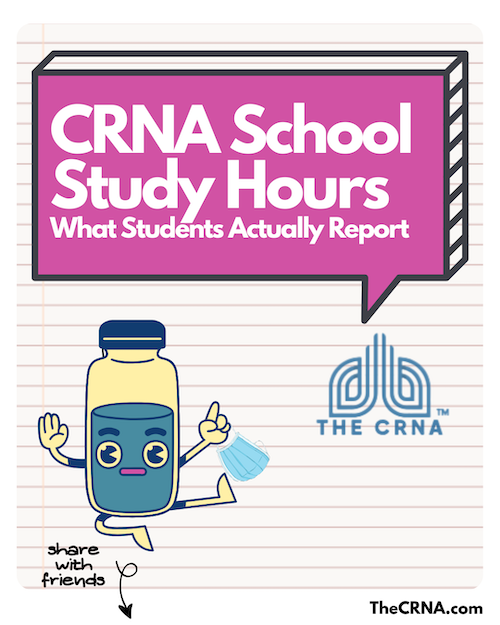
1. Wide Range of Study Hours Reported
CRNA students describe a spectrum of study time that shifts with course load and exam timing. On light weeks, some manage with 3–4 focused hours per day to keep pace with readings, quizzes, and note reviews. Many settle around 6–8 hours daily, especially during heavy physiology, pharmacology, and pathophysiology blocks. In the run-up to major exams or complex units, totals can surge to 10+ hours per day for several days. When class, clinical, and self-study are combined, weeks of 40–60 hours are common, and a subset report peaks of 60–80 hours during front-loaded didactic or when multiple assessments align.
2. CRNA School Treated Like a Full-Time Job (or More)
Many commenters recommend approaching CRNA school like a structured job to maintain stamina and consistency. A typical rhythm is 8am–4pm or 9am–5pm of coursework and self-study on non-clinical days, then adding targeted review in the evenings prior to exams. This “workday” framing helps avoid aimless marathon sessions and guards energy for the long haul. Several students also earmark a half-day on weekends for catch-up or previewing the next unit. Others keep evenings lighter (flashcards, key concept refreshers) to protect sleep. The throughline: reliable daily blocks beat sporadic cramming, and predictable hours make it easier to communicate with family and manage life logistics.
3. Didactic Phase Is the Most Demanding
Front-loaded didactic terms often feel like drinking from a firehose: dense lecture schedules, rapid content turnover, and frequent quizzes. Students report heavier content assimilation here—building frameworks for anesthesia physiology, pharmacology, and equipment—before layering clinical nuance later. Once clinicals begin, total weekly time commitment rarely drops; it simply rebalances. Long clinical days can leave little bandwidth for deep study at night, so many shift major learning to weekends, early mornings, or designated off-days. Efficiency becomes crucial: skimming low-yield material gives way to targeted review of concepts that directly influence patient management and exam performance.
4. 12–16 Hours Per Day Isn’t the Norm
While some programs caution students to expect 12–16 hours daily, the consensus in the thread is that such volume, every day, is neither sustainable nor required for most learners. Occasional grind days happen—stacked exams, major projects, or catching up after illness—but living at that pace typically signals inefficient methods (passive rereading, unfocused note-making, or chasing every detail equally). Many students report stronger outcomes from 4–6 hours of high-quality, active study than from double the time spent passively. Hallmarks of efficient weeks include specific goals, timed sessions, spaced retrieval, and honest assessment of weak spots rather than blanket repetition.
5. Study Methods and Strategies Make a Difference
- Active recall & spaced repetition: Flashcards and question banks to force retrieval, with intervals that expand as mastery grows.
- Pomodoro & focus blocks: 25–50 minute sprints with short breaks to preserve attention and reduce burnout.
- Tiered note systems: Condense lecture notes into exam-ready outlines, then distill again into one-page quick sheets.
- High-yield targeting: Prioritize physiology mechanisms, drug classes, and clinical decision points most likely to drive anesthesia care and exams.
- Teach-back/whiteboard: Explaining aloud (solo or with peers) exposes gaps faster than rereading.
- Evidence of learning: Track questions missed, error patterns, and concepts requiring spaced revisits; let data steer the next session.
6. Individual Differences Matter a Lot
Study volume varies with baseline knowledge, reading speed, test-taking skill, and personal responsibilities. Students with strong undergrad science foundations or faster retention may thrive at the lower end of the hour range, while others need more repetitions to feel safe in high-stakes settings. Program structure also matters—front-loaded vs. integrated curricula, commute demands, and clinical site expectations. Family life, jobs (if any), and health can shift capacity day-to-day. The practical advice from the thread: benchmark yourself during the first term, calibrate hours to outcomes (quiz and exam results), and adjust inputs (methods and time) rather than assuming a universal number is correct.
7. Balance and Mental Health Are Critical
Students repeatedly emphasize that sustainable success requires deliberate recovery: sleep, nutrition, movement, and boundaries. Even on heavy weeks, short workouts, walks, or mindfulness breaks help protect focus and mood. Pre-planned downtime with family or hobbies reduces the temptation to disengage for entire days later. Many treat evenings before major clinical days as lighter review only, reserving deep study for weekends or off-days. Signs you may need to rebalance include unproductive late-night sessions, frequent rereads without retention, or rising anxiety before routine quizzes. The collective message: protect your engine—consistent, high-quality effort beats unsustainable sprints, and the grind is temporary compared with the long career payoff as a CRNA.


